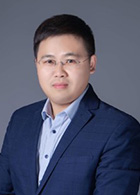

 Yun-Feng Xiao was born in Gaoan, Jiangxi Province in January of 1981. Now he is a distinguished “Boya” Professor in School of Physics at Peking University. He received the B.S. and Ph.D. degrees in physics from University of Science and Technology of China in 2002 and 2007, respectively. After his postdoctoral research at Washington University in St. Louis, he joined Peking University as an assistant professor in January of 2009, and was subsequently promoted to associate and full professor with tenure in 2014 and 2018, respectively. His research interests lie in the fields of whispering-gallery microcavity optics and photonics, and has authored or co-authored more than 160 peer-reviewed papers with over 4000 citations in top international journals including Science, Nature Photonics, PNAS, Physical Review Letters and Advanced materials. His researches were selected as “Ten Major Scientific and Technological Progress of China’s Colleges and Universities” twice, in 2014 and 2017, respectively.
Yun-Feng Xiao was born in Gaoan, Jiangxi Province in January of 1981. Now he is a distinguished “Boya” Professor in School of Physics at Peking University. He received the B.S. and Ph.D. degrees in physics from University of Science and Technology of China in 2002 and 2007, respectively. After his postdoctoral research at Washington University in St. Louis, he joined Peking University as an assistant professor in January of 2009, and was subsequently promoted to associate and full professor with tenure in 2014 and 2018, respectively. His research interests lie in the fields of whispering-gallery microcavity optics and photonics, and has authored or co-authored more than 160 peer-reviewed papers with over 4000 citations in top international journals including Science, Nature Photonics, PNAS, Physical Review Letters and Advanced materials. His researches were selected as “Ten Major Scientific and Technological Progress of China’s Colleges and Universities” twice, in 2014 and 2017, respectively.
He was recipient of Outstanding Youth Fund (NSFC, 2012) and Distinguished Youth Fund (NSFC, 2018), and was selected as Changjiang Distinguished Professor (MOE, 2018) and Innovation Leadership Program for Young and Middle-aged Scientists in China (MOST, 2018). Owing to his fundamental contributions to the field of optical microcavities, he received numerous awards, including Rao-Yutai Prize in Fundamental Optics (COS, 2013), Wang-Daheng Optics Prize (COS, 2018), Youth Science Award (MOE, 2018) and Rao-Yutai Prize in physics (CPS, 2018-2019). He was elected a Fellow of OSA in 2019, and serves/served as an Associate Editor of several journals including Light: Science & Applications, Photonics Research, Science China: Physics, Mechanics & Astronomy, Chinese Optics Letters and Frontier of Optoelectronics. He is also serving as the chairman or vice-chairman in several important committees.